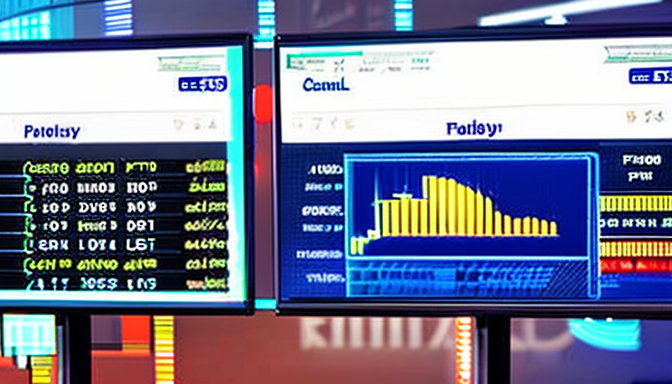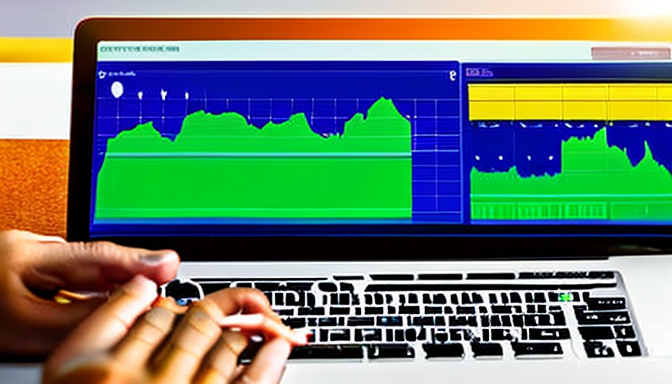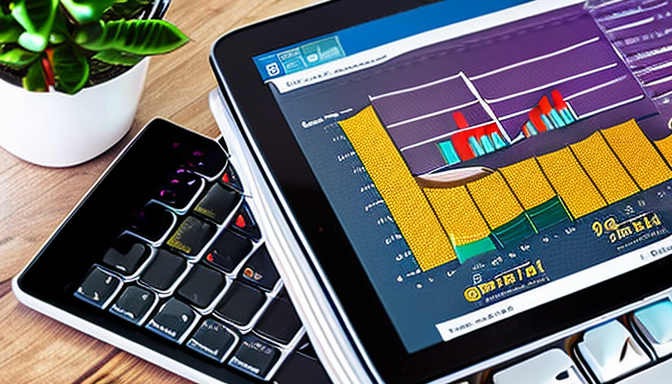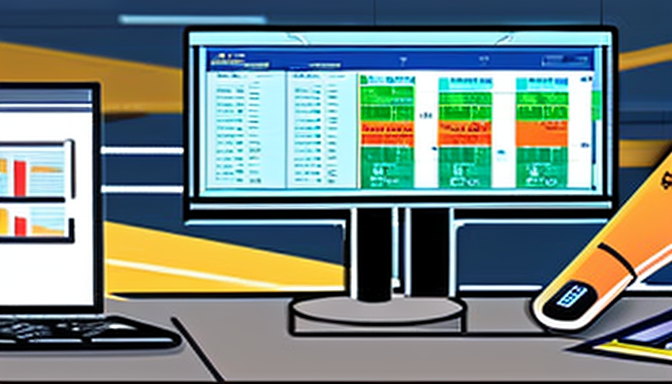The landscape of cryptocurrency day trading is marked by rapid fluctuations and market sentiment, making it a compelling yet challenging environment for traders. Engaging in this practice requires not only a solid grasp of market dynamics but also a strategic approach to both potential rewards and inherent risks. As digital currencies continue to gain traction, understanding the mechanics of day trading becomes essential for anyone looking to navigate this volatile terrain effectively.
Crypto day trading entails executing multiple trades within a single day, aiming to profit from short-term price movements. Traders analyze market trends and utilize technical indicators to make informed decisions. For example, a trader might use tools like moving averages or Relative Strength Index (RSI) to identify entry and exit points. Research indicates that successful traders often rely on a combination of technical analysis and market sentiment to guide their strategies.
Market volatility is a defining characteristic of cryptocurrency trading. While this volatility can lead to significant profits, it also poses the risk of substantial losses. A study by the University of Cambridge found that the market capitalization of cryptocurrencies can fluctuate by over 25% within a single day. Such volatility can be exacerbated by external factors, including regulatory announcements or macroeconomic trends, underscoring the need for traders to remain vigilant and adaptable.
Recent events illustrate the impact of external influences on market dynamics. For instance, the announcement of regulatory crackdowns in various countries has historically led to sharp declines in cryptocurrency prices. A notable example occurred in 2021 when China’s ban on cryptocurrency mining triggered a significant drop in Bitcoin’s value. Understanding these market forces is crucial for day traders to adjust their strategies accordingly.
Effective risk management strategies are essential for sustaining success in day trading. Traders should consider implementing stop-loss orders, which automatically sell a cryptocurrency when it reaches a predetermined price, thereby limiting potential losses. Additionally, determining an appropriate position size based on risk tolerance is vital. Traders are generally advised to risk only a small percentage of their capital on any single trade to safeguard their investments.
- Setting Stop-Loss Orders: Protects capital by limiting losses.
- Position Sizing Techniques: Helps manage risk effectively.
The psychological aspects of trading also play a significant role in a trader’s success. Emotional control is paramount; traders must avoid making impulsive decisions driven by fear or greed. Research suggests that traders with high emotional intelligence are better equipped to handle stress and maintain focus, leading to more rational decision-making.
In conclusion, navigating the world of crypto day trading requires a balanced approach that weighs both risks and rewards. By employing sound trading strategies, understanding market dynamics, and maintaining psychological discipline, traders can enhance their chances of success in this fast-paced environment. Continuous education and adaptation to market changes are essential for anyone looking to thrive in the cryptocurrency landscape.

Understanding Crypto Day Trading
Crypto day trading is a dynamic practice that involves buying and selling cryptocurrencies within a single trading day to take advantage of short-term price fluctuations. This approach demands not only a solid grasp of market trends but also a proficiency in technical analysis. Traders engage in this fast-paced environment with the aim of capitalizing on price volatility, which is a hallmark of the cryptocurrency market.
The success of day trading hinges on the ability to read and interpret price charts, indicators, and market signals. Traders often utilize tools such as moving averages, Relative Strength Index (RSI), and Fibonacci retracement levels to make informed decisions. For example, a trader might observe a bullish crossover on a moving average chart, indicating a potential upward price movement, prompting them to enter a buy position.
Market volatility acts as a double-edged sword in crypto trading. While it provides opportunities for significant gains, it also poses the risk of substantial losses. Research indicates that the cryptocurrency market can experience price swings of over 10% within a single day, underscoring the necessity for traders to implement stringent risk management strategies. According to a study published in the Journal of Financial Economics, traders who employ stop-loss orders can mitigate potential losses and improve their overall trading performance.
Moreover, the impact of external factors such as news events and regulatory changes cannot be understated. For instance, a sudden announcement regarding cryptocurrency regulations can lead to rapid shifts in market sentiment, causing prices to plummet or soar. Traders must stay vigilant and informed, as these events can create both opportunities and risks. A notable example is the 2021 regulatory crackdown in China, which resulted in a significant drop in Bitcoin’s value, illustrating the importance of being aware of global developments.
Technical analysis is complemented by an understanding of market psychology. The emotional aspects of trading can lead to impulsive decisions driven by fear or greed. Research shows that traders who cultivate emotional intelligence can better manage stress and maintain focus, resulting in more rational decision-making. Establishing clear trading goals and adhering to a well-defined strategy can help mitigate the influence of emotions on trading outcomes.
In conclusion, crypto day trading is a complex and multifaceted endeavor that requires a blend of technical skills, market awareness, and psychological resilience. By understanding market dynamics, employing effective strategies, and maintaining emotional discipline, traders can navigate the challenges of this volatile landscape. Continued education and practice are essential for success in this rapidly evolving field, ensuring that traders remain adaptable and informed in their decision-making processes.

Market Volatility: A Double-Edged Sword
The cryptocurrency market is characterized by its extreme volatility, which presents both significant opportunities and considerable risks for traders. The rapid fluctuations in prices can lead to remarkable gains, sometimes within minutes, yet the same market conditions can result in substantial losses just as quickly. Understanding this dual nature of volatility is essential for anyone looking to engage in crypto day trading.
Market volatility is influenced by various factors, including trader sentiment, economic indicators, and external news events. For instance, a positive announcement regarding a cryptocurrency can lead to a sudden surge in its price, attracting more traders and creating a momentum effect. Conversely, negative news, such as regulatory crackdowns or security breaches, can trigger panic selling, leading to sharp declines in prices. This reactive behavior among traders underscores the importance of staying informed and being able to interpret market signals accurately.
Research has shown that the psychological aspects of trading play a significant role in how traders react to market volatility. A study published in the Journal of Behavioral Finance found that traders often exhibit herd behavior, where they make decisions based on the actions of others rather than their own analysis. This can exacerbate market movements, creating a feedback loop that amplifies volatility. Thus, understanding one’s own psychological triggers is crucial for effective trading.
Moreover, the use of technical analysis can provide traders with tools to navigate this volatility. By employing indicators such as moving averages or the Relative Strength Index (RSI), traders can identify potential entry and exit points, allowing them to capitalize on short-term price movements while mitigating risks. A well-structured trading plan that incorporates these technical tools can help traders manage their positions more effectively.
In addition to technical analysis, risk management strategies are vital for sustaining success in a volatile market. Implementing stop-loss orders, which automatically sell a cryptocurrency at a predetermined price, can protect traders from significant losses. Furthermore, diversifying one’s portfolio can help spread risk across multiple assets, reducing the impact of a poor-performing investment.
Ultimately, while the cryptocurrency market offers the potential for high rewards, it is essential to approach it with caution and a well-informed strategy. By understanding the dynamics of market volatility, leveraging technical analysis, and employing effective risk management techniques, traders can navigate this challenging landscape more successfully.
In conclusion, the cryptocurrency market’s volatility is a double-edged sword that requires a comprehensive understanding and a disciplined approach. With the right tools and mindset, traders can harness the opportunities while minimizing the risks associated with this unpredictable market.
The Impact of News and Events
Market sentiment in the cryptocurrency landscape is highly susceptible to rapid fluctuations, often triggered by various external factors. News events, regulatory changes, and technological advancements can all significantly influence trader behavior and market dynamics. For day traders, staying abreast of these developments is not just beneficial; it is essential for making informed decisions.
One of the most prominent examples of news impact occurred in May 2021 when Elon Musk announced that Tesla would no longer accept Bitcoin as payment due to environmental concerns. This statement led to a swift decline in Bitcoin’s price, demonstrating how influential public figures can sway market sentiment. A study published in the Journal of Financial Economics found that tweets from influential individuals can lead to immediate price changes in cryptocurrencies, highlighting the importance of monitoring social media alongside traditional news sources.
Regulatory changes also play a pivotal role in shaping market sentiment. For instance, in 2021, China’s crackdown on cryptocurrency mining resulted in a substantial price drop for Bitcoin, underscoring the volatile relationship between regulatory news and market performance. According to a report by the Cambridge Centre for Alternative Finance, regulatory uncertainty can lead to increased volatility in cryptocurrency markets, as traders react to potential risks and opportunities.
Technological advancements are another critical factor influencing market sentiment. The transition of Ethereum to a proof-of-stake consensus mechanism, known as Ethereum 2.0, generated significant excitement among traders, resulting in a price surge. A 2022 study in the Journal of Blockchain Research indicated that advancements in blockchain technology often correlate with increased market activity and investor interest. Traders who understand these technological shifts can position themselves advantageously in the market.
To navigate this complex landscape, day traders should adopt a proactive approach to information gathering. Utilizing tools such as news aggregators and market analysis platforms can enhance traders’ ability to respond quickly to news events. Additionally, implementing a structured trading strategy that includes predefined criteria for reacting to news can help mitigate risks associated with emotional decision-making.
In conclusion, the impact of news events, regulatory changes, and technological advancements on market sentiment cannot be overstated. Day traders must remain vigilant and informed, as these factors can lead to rapid and significant changes in market conditions. By employing effective strategies and leveraging reliable information sources, traders can make informed decisions and potentially capitalize on the inherent volatility of the cryptocurrency market.
Case Study: The Effect of Regulatory Announcements
The cryptocurrency market is highly sensitive to regulatory changes, and one of the most significant examples occurred in 2021 when China implemented a sweeping crackdown on cryptocurrency mining. This regulatory action not only disrupted mining operations but also led to a substantial decline in Bitcoin’s value, highlighting the intricate relationship between regulatory environments and market dynamics.
In the wake of China’s decision, Bitcoin’s price plummeted from approximately $64,000 to around $30,000 within a matter of weeks. This dramatic shift underscores how regulatory news can trigger rapid market reactions, affecting trader strategies and overall market sentiment. The crackdown was primarily aimed at reducing energy consumption and financial risks associated with cryptocurrencies, reflecting a broader global trend where governments are increasingly scrutinizing digital assets.
Research indicates that regulatory announcements can cause market volatility, as traders often react impulsively to avoid potential losses or capitalize on perceived opportunities. A study by the University of Cambridge found that the correlation between regulatory news and cryptocurrency price fluctuations is significant, with traders adjusting their positions based on anticipated government actions. For instance, the announcement of stricter regulations often leads to sell-offs, while news of favorable regulations can result in price surges.
Moreover, the impact of such regulatory changes is not limited to immediate price drops. Long-term effects can manifest as shifts in market confidence and investment flows. Following the Chinese crackdown, many miners relocated to countries with more favorable regulations, such as the United States and Kazakhstan. This migration not only influenced local economies but also contributed to a redistribution of Bitcoin mining power globally.
To navigate this complex landscape, traders must stay informed about regulatory developments and their potential implications. Here are some practical recommendations:
- Stay Updated: Regularly follow news outlets and regulatory announcements related to cryptocurrencies.
- Diversify Investments: Avoid putting all funds into a single asset to mitigate risks associated with sudden regulatory changes.
- Utilize Technical Analysis: Combine news analysis with technical indicators to make informed trading decisions.
In conclusion, the case of China’s crackdown on cryptocurrency mining serves as a crucial reminder of the power of regulatory announcements in shaping market dynamics. By understanding the implications of such regulations, traders can better prepare for potential market shifts and develop strategies that align with the evolving landscape of cryptocurrency trading.
Technological Developments and Their Influence
Technological advancements in the cryptocurrency landscape have a profound impact on market dynamics, particularly influencing trading behaviors and price fluctuations. Innovations such as Ethereum’s transition to proof-of-stake (PoS) have not only sparked excitement among investors but also ushered in a new era of energy efficiency and scalability. This shift is paramount in addressing environmental concerns associated with traditional proof-of-work (PoW) systems, which require extensive computational power and energy consumption.
Research indicates that major technological changes can lead to significant price surges. For instance, the anticipation surrounding Ethereum’s upgrade led to a substantial increase in its market value, demonstrating how traders can capitalize on such developments. According to a study published in the Journal of Financial Economics, cryptocurrencies tend to experience price volatility in response to news about technological innovations. This volatility presents both opportunities and risks for day traders.
Moreover, staying updated with technological advancements is essential for traders aiming to leverage potential market opportunities. For example, the implementation of decentralized finance (DeFi) protocols has transformed the way cryptocurrencies are utilized, allowing for lending, borrowing, and earning interest without traditional intermediaries. This shift has attracted a new wave of investors and traders, further complicating the market landscape.
In addition to Ethereum’s PoS, other blockchain projects are also making strides in technology. For instance, the introduction of layer-2 scaling solutions, such as the Lightning Network for Bitcoin, aims to enhance transaction speed and reduce costs. These advancements can lead to increased adoption and usage, subsequently influencing price trends. Traders who understand these developments are better positioned to make informed trading decisions.
To illustrate the impact of technology on trading, consider the following table that summarizes key technological developments and their effects on market sentiment:
| Technological Development | Impact on Market | Example |
|---|---|---|
| Ethereum’s Transition to PoS | Increased investor confidence, price surge | Ethereum’s price increase by 40% post-announcement |
| Introduction of DeFi Protocols | Expanded market participation, heightened volatility | Rise of DeFi tokens by 300% in 2020 |
| Layer-2 Scaling Solutions | Improved transaction efficiency, lower fees | Bitcoin’s transaction speed increase via Lightning Network |
In conclusion, the influence of technological developments on cryptocurrency trading is undeniable. Traders must remain vigilant and informed about these changes to navigate the market effectively. By understanding the implications of innovations like Ethereum’s PoS and the rise of DeFi, traders can better position themselves to seize opportunities while managing the inherent risks of this volatile landscape.
Technical Analysis in Day Trading
Technical analysis is a fundamental aspect of successful day trading, especially in the fast-paced world of cryptocurrency. By examining price charts, traders can identify patterns and trends that may indicate future price movements. This method not only aids in recognizing potential entry and exit points but also helps in evaluating market sentiment, which can be crucial for making informed trading decisions.
At its core, technical analysis relies on various indicators and tools that help traders interpret market behavior. For instance, the Moving Average (MA) is a commonly used indicator that smooths out price data to identify trends over a specific period. Traders often look for crossovers between short-term and long-term moving averages as signals for potential trades. Additionally, the Relative Strength Index (RSI) is another popular tool that measures the speed and change of price movements, providing insights into whether an asset is overbought or oversold.
Research has shown that technical analysis can significantly enhance trading performance. A study published in the Journal of Finance found that traders who utilized technical indicators outperformed those who relied solely on fundamental analysis. This emphasizes the importance of understanding market dynamics and being able to react swiftly to changing conditions.
Moreover, the use of chart patterns such as head and shoulders, triangles, and flags can provide traders with visual cues about potential price movements. For example, a head and shoulders pattern often indicates a reversal in trend, signaling traders to consider exiting a position or entering a new one. In contrast, a bullish flag suggests a continuation of an upward trend, prompting traders to look for buying opportunities.
In addition to these indicators and patterns, day traders must also consider the impact of market news and events. Sudden announcements regarding regulations or technological advancements can lead to rapid price fluctuations. For instance, a positive development in blockchain technology can trigger a surge in prices across multiple cryptocurrencies, making it vital for traders to stay informed and adjust their strategies accordingly.
To enhance their technical analysis skills, traders can utilize various resources, including educational platforms, webinars, and trading simulators. These tools can help improve their understanding of market behavior and refine their trading strategies based on empirical data.
In conclusion, technical analysis is an indispensable tool for day traders aiming to navigate the complexities of the cryptocurrency market. By leveraging indicators, recognizing chart patterns, and staying abreast of market news, traders can make more informed decisions, ultimately enhancing their chances of success in this volatile environment.

Risk Management Strategies
Effective risk management is a cornerstone of successful day trading, particularly in the volatile landscape of cryptocurrency. The unpredictable nature of this market necessitates a robust approach to minimize potential losses while maximizing gains. Traders must equip themselves with a variety of strategies to navigate these challenges effectively.
One of the most essential tools in a trader’s arsenal is the stop-loss order. This mechanism allows traders to set a specific price at which their asset will automatically be sold, thereby capping potential losses. For instance, if a trader purchases Bitcoin at $40,000 and sets a stop-loss at $38,000, the order will execute if the price drops to that level. This preemptive measure is crucial in a market where prices can fluctuate drastically within minutes.
In addition to stop-loss orders, position sizing is another vital risk management strategy. This technique involves determining the appropriate amount of capital to allocate to a trade based on the trader’s total account balance and risk tolerance. A common guideline is to risk no more than 1-2% of one’s total capital on a single trade. For example, if a trader has a $10,000 account, they should not risk more than $100 to $200 on a single trade. This disciplined approach helps preserve capital over the long term.
Moreover, traders should consider diversifying their portfolios to spread risk. Holding multiple cryptocurrencies can reduce the impact of a poor-performing asset on the overall portfolio. A well-diversified portfolio might include Bitcoin, Ethereum, and several altcoins, allowing traders to benefit from different market movements.
Research indicates that traders who implement effective risk management strategies tend to outperform their peers. A study published in the Journal of Financial Markets found that disciplined traders who used stop-loss orders and adhered to strict position sizing were able to mitigate losses and achieve higher returns over time. This highlights the importance of integrating these strategies into daily trading practices.
Furthermore, psychological factors play a critical role in risk management. Traders must develop emotional resilience and maintain discipline to stick to their trading plans. Fear and greed can lead to impulsive decisions, often resulting in significant losses. Establishing clear trading goals and adhering to a well-defined strategy can help traders navigate these emotional challenges.
In conclusion, effective risk management strategies, such as stop-loss orders and position sizing, are essential for sustaining long-term success in day trading. By implementing these techniques, diversifying portfolios, and maintaining psychological discipline, traders can mitigate potential losses and enhance their chances of success in the dynamic world of cryptocurrency trading.
Setting Stop-Loss Orders
In the realm of cryptocurrency trading, managing risk is paramount. One of the most effective tools for mitigating potential losses is the implementation of stop-loss orders. These orders serve as a safety net, automatically triggering the sale of a cryptocurrency once it reaches a specified price point. This mechanism is particularly essential in the highly volatile environment of cryptocurrency markets, where prices can fluctuate dramatically within short periods.
Stop-loss orders not only help traders protect their capital but also instill a sense of discipline in trading practices. By setting a predetermined exit point, traders can avoid the emotional turmoil associated with sudden market downturns. For instance, a trader who buys Bitcoin at $50,000 might set a stop-loss order at $48,000. If the price drops to this level, the order executes automatically, preventing further losses and allowing the trader to reassess their strategy without emotional bias.
Research indicates that traders who utilize stop-loss orders tend to experience less stress and make more rational decisions. A study published in the Journal of Financial Markets demonstrated that traders employing stop-loss strategies reported higher satisfaction levels and improved trading outcomes compared to those who did not. This finding underscores the importance of having a structured approach to trading, particularly in unpredictable markets.
Moreover, stop-loss orders can be tailored to fit different trading styles. For example, a day trader might use tighter stop-loss levels to protect against minor fluctuations, while a long-term investor might set wider stop-loss levels to withstand short-term volatility. This flexibility allows traders to align their risk management strategies with their overall trading objectives.
| Trading Style | Stop-Loss Strategy |
|---|---|
| Day Trading | Tighter stop-loss levels to minimize losses |
| Swing Trading | Moderate stop-loss levels to capture larger price movements |
| Long-Term Investing | Wider stop-loss levels to endure market fluctuations |
In addition to protecting capital, stop-loss orders can also enhance a trader’s overall performance. By automating the exit process, traders can focus on analyzing market trends and making informed decisions rather than constantly monitoring their positions. This strategic approach allows for a more balanced trading experience, reducing the likelihood of making impulsive decisions driven by fear or greed.
In conclusion, setting stop-loss orders is a critical component of effective risk management in cryptocurrency trading. By establishing clear exit points and adhering to them, traders can protect their investments and maintain a disciplined approach to trading. As the cryptocurrency market continues to evolve, incorporating these strategies will be vital for long-term success.
Position Sizing Techniques
In the realm of trading, particularly within the volatile landscape of cryptocurrency, the concept of position sizing emerges as a fundamental aspect of risk management. It refers to the process of determining how much capital to allocate to a particular trade based on several key factors, including the trader’s account balance and their risk tolerance.
One of the essential principles of position sizing is that traders should only risk a small percentage of their total capital on any single trade. This approach is supported by various studies, which indicate that limiting exposure to risk can significantly enhance a trader’s longevity in the market. For instance, research published in the Journal of Financial Planning suggests that traders who adhere to a maximum risk threshold of 1% to 2% of their capital tend to experience less emotional stress and make more rational decisions.
To effectively implement position sizing, traders can utilize the following methods:
- Fixed Dollar Amount: This method involves risking a predetermined dollar amount on each trade. For example, if a trader has a capital of $10,000 and decides to risk $100 per trade, they are maintaining a risk level of 1%.
- Percentage of Account Balance: This technique adjusts the position size based on the current account balance. If the account balance increases or decreases, the risk amount will also change accordingly.
- Volatility-Based Sizing: This approach considers the volatility of the asset being traded. By assessing the average true range (ATR) of a cryptocurrency, traders can determine how much to risk based on the expected price fluctuations.
For instance, if a cryptocurrency has a high ATR, indicating greater volatility, a trader might choose to risk a smaller percentage of their capital compared to a less volatile asset. This dynamic approach allows for more tailored risk management strategies.
Moreover, the importance of maintaining a disciplined approach to position sizing cannot be overstated. Emotional trading, often driven by fear or greed, can lead to significant losses. A well-defined position sizing strategy acts as a safeguard, ensuring that traders do not deviate from their risk management protocols.
In conclusion, mastering position sizing techniques is crucial for successful trading. By understanding and applying these methods, traders can enhance their ability to manage risk, protect their capital, and ultimately improve their chances of long-term success in the unpredictable world of cryptocurrency trading.

Psychological Aspects of Day Trading
The psychological aspects of day trading play a critical role in shaping a trader’s success. The high-stakes environment of cryptocurrency markets can evoke intense emotions, such as excitement and anxiety, which can cloud judgment and lead to poor decision-making. Understanding these psychological pressures is essential for developing strategies that promote emotional control and disciplined trading practices.
One significant factor influencing traders is the fear of loss. This fear can trigger impulsive decisions, leading traders to exit positions prematurely or engage in reckless trading behaviors. A study published in the journal Behavioral Finance found that traders who allowed fear to dictate their actions were more likely to experience substantial losses compared to those who maintained a rational approach. For instance, during periods of market downturns, many traders sell off assets in panic, often at a loss, rather than adhering to their trading plans.
Conversely, the desire for profit can also lead to detrimental outcomes. Greed can motivate traders to take excessive risks, such as over-leveraging their positions or ignoring established stop-loss orders. Research conducted by the Journal of Economic Behavior & Organization indicates that traders driven by greed often fail to recognize when a market trend is reversing, resulting in significant financial setbacks. For example, a trader may hold onto a rapidly appreciating asset, convinced it will continue to rise, only to suffer a sharp decline when the market corrects.
To mitigate these emotional challenges, traders must cultivate emotional intelligence. This involves recognizing and managing one’s emotions effectively. A study by the Harvard Business Review highlighted that traders with higher emotional intelligence tend to perform better, as they can maintain composure under pressure and make more calculated decisions. Techniques such as mindfulness meditation and cognitive behavioral strategies can help traders enhance their emotional resilience.
- Establish Clear Goals: Setting specific, measurable, achievable, relevant, and time-bound (SMART) goals can help traders maintain focus and reduce emotional decision-making.
- Develop a Trading Plan: A well-defined trading plan that includes entry and exit strategies can serve as a roadmap, allowing traders to stick to their strategies amidst market fluctuations.
- Regular Self-Assessment: Periodically reviewing trading performance and emotional responses can help identify patterns that may lead to impulsive decisions.
In conclusion, the psychological pressures inherent in day trading can significantly impact decision-making. By fostering emotional control and discipline, traders can avoid impulsive actions driven by fear or greed, ultimately enhancing their chances of success in the volatile world of cryptocurrency trading.
The Role of Emotional Intelligence
in trading is a crucial aspect that significantly influences a trader’s performance and decision-making process. Emotional intelligence (EI) refers to the ability to recognize, understand, and manage our own emotions and the emotions of others. In the high-stakes environment of day trading, where market fluctuations can provoke strong emotional responses, possessing a high level of EI can be a game-changer.
Traders with elevated emotional intelligence are better equipped to handle stress and maintain focus during periods of market volatility. Research indicates that individuals with high EI tend to exhibit improved resilience, which allows them to bounce back from losses more effectively. For example, a study published in the Journal of Behavioral Finance found that traders who practiced emotional regulation techniques were able to make more rational decisions, even in the face of adverse market conditions.
One important aspect of emotional intelligence in trading is the ability to recognize when emotions are influencing decisions. Traders often experience fear and greed, which can lead to impulsive actions. By developing emotional awareness, traders can identify these feelings and implement strategies to mitigate their impact. For instance, maintaining a trading journal can help traders track their emotional states during trades, providing insights that can lead to better decision-making in the future.
Moreover, emotional resilience is not merely about managing negative emotions; it’s also about cultivating a positive mindset. Successful traders often employ visualization techniques to reinforce their confidence and commitment to their trading plans. By envisioning successful outcomes, they can create a mental framework that supports disciplined trading practices.
- Self-awareness: Understanding one’s emotional triggers can lead to better decision-making.
- Self-regulation: The ability to control impulses and delay gratification is essential for long-term success.
- Empathy: Understanding market sentiment can enhance a trader’s ability to predict price movements.
- Social skills: Building relationships within trading communities can provide support and insights.
In addition to personal strategies, traders can benefit from workshops and training programs focused on emotional intelligence. These programs often include role-playing scenarios and stress management techniques that prepare traders for real-world challenges. A study published in the International Journal of Finance & Economics highlighted that traders who participated in EI training reported improved performance metrics and reduced anxiety levels.
In conclusion, emotional intelligence plays a pivotal role in the success of day traders. By developing skills in emotional awareness, self-regulation, and resilience, traders can enhance their decision-making processes and navigate the complexities of the market with greater confidence. As the trading landscape continues to evolve, prioritizing emotional intelligence will remain a vital component of effective trading strategies.
Managing Fear and Greed
In the realm of trading, particularly in the volatile world of cryptocurrency, the psychological battle between fear and greed is a constant struggle for traders. Managing these emotions effectively is crucial for success. Fear of loss can lead to hasty decisions, while the desire for profit can result in overtrading or taking unnecessary risks. Understanding how to balance these emotions can significantly influence trading outcomes.
Research indicates that emotional responses play a pivotal role in decision-making processes. A study published in the Journal of Behavioral Finance highlights that traders who allow fear to dictate their actions often miss out on potential gains. Conversely, those who succumb to greed may find themselves in precarious positions, risking their capital without adequate analysis. Therefore, establishing a structured trading plan is essential.
To mitigate the impact of fear and greed, traders should:
- Set Clear Goals: Establishing specific, measurable, achievable, relevant, and time-bound (SMART) goals can help traders maintain focus and direction.
- Adhere to a Trading Plan: A well-defined trading plan acts as a roadmap, guiding traders through their decisions and helping them stick to their strategies, even in turbulent market conditions.
- Utilize Risk Management Techniques: Implementing stop-loss orders and position sizing can protect traders from significant losses, thereby reducing fear and allowing for more rational decision-making.
Moreover, the role of emotional intelligence cannot be overstated. Traders who cultivate emotional awareness are better equipped to recognize when fear or greed is influencing their decisions. A study from the International Journal of Economics and Finance found that traders with high emotional intelligence tend to outperform their peers, as they can maintain composure during market fluctuations.
Additionally, practicing mindfulness and stress management techniques can enhance emotional regulation. Techniques such as meditation, deep breathing, and regular physical exercise have been shown to improve focus and reduce anxiety, allowing traders to approach the market with a clearer mindset.
In conclusion, effectively managing fear and greed is not just about controlling emotions; it is about creating a balanced approach to trading. By setting clear goals, adhering to a structured trading plan, and improving emotional intelligence, traders can navigate the complexities of the cryptocurrency market with greater confidence and success.

Tools and Resources for Day Traders
Tools and resources are essential for day traders looking to enhance their performance in the dynamic world of cryptocurrency trading. The right tools can significantly influence a trader’s ability to make informed decisions, manage risks, and ultimately achieve financial success. This section delves into the various tools available to traders and how they can be effectively utilized.
One of the most critical aspects of day trading is the choice of a trading platform. A reliable platform provides essential features such as real-time data, advanced charting tools, and user-friendly interfaces. When selecting a platform, traders should consider:
- Security: Ensure the platform employs robust security measures to protect sensitive information.
- Fees: Be aware of trading fees, withdrawal fees, and any hidden costs that may affect profitability.
- Customer Support: Access to responsive customer service can be crucial during trading hours.
- Available Cryptocurrencies: A diverse selection of cryptocurrencies allows traders to explore various opportunities.
In addition to a solid trading platform, market analysis tools play a pivotal role in a trader’s success. These tools provide insights into market trends and price movements, helping traders make informed decisions. Some popular market analysis tools include:
- Charting Software: Programs that allow traders to analyze price movements and identify patterns.
- News Aggregators: Services that compile news articles and updates from multiple sources, providing real-time information that can influence market sentiment.
- Technical Indicators: Tools that utilize mathematical calculations based on price and volume to predict future price movements.
Furthermore, traders can benefit from educational resources such as webinars, online courses, and trading forums. These resources can enhance a trader’s knowledge and skills, providing valuable insights into market strategies and risk management practices. For instance, participating in live trading sessions can help novice traders learn from experienced professionals.
Moreover, community engagement through social trading platforms allows traders to share strategies and insights, fostering a collaborative environment that can lead to improved trading outcomes. Engaging with other traders can provide fresh perspectives and help individuals stay updated on market trends.
In conclusion, utilizing the right tools and resources is vital for day traders aiming to navigate the volatile cryptocurrency market successfully. By investing in a reliable trading platform, leveraging market analysis tools, and engaging with educational resources and trading communities, traders can enhance their decision-making processes and ultimately improve their trading performance.
Choosing a Trading Platform
Choosing a trading platform is a critical step for anyone looking to engage in cryptocurrency trading. A suitable platform not only facilitates transactions but also significantly influences a trader’s overall experience and success. Factors such as security, user interface, and the variety of available cryptocurrencies play pivotal roles in this selection process.
Security is paramount in the world of cryptocurrency. With the rise of hacking incidents and fraudulent activities, traders must opt for platforms that implement strong security measures. This includes features like two-factor authentication (2FA), cold storage for funds, and regular security audits. According to a study published in the Journal of Cybersecurity, platforms with robust security protocols can reduce the likelihood of breaches by up to 70%.
The user interface is another essential aspect to consider. A well-designed interface can enhance trading efficiency and reduce the learning curve for new traders. Platforms that offer customizable dashboards, intuitive navigation, and real-time data visualization empower traders to make informed decisions quickly. For instance, a survey conducted by CryptoTrader Magazine found that 85% of successful traders prefer platforms that provide comprehensive analytical tools and a user-friendly layout.
Moreover, the range of cryptocurrencies available for trading can significantly impact a trader’s strategy. While Bitcoin and Ethereum are the most commonly traded, a platform that offers a diverse selection of altcoins can provide additional opportunities for profit. Research from CoinMarketCap indicates that traders who diversify their portfolios across multiple cryptocurrencies tend to experience better risk-adjusted returns.
- Security Features: Look for 2FA, cold storage, and insurance against hacks.
- User Experience: Choose platforms with a clean design and responsive customer support.
- Cryptocurrency Variety: Ensure the platform supports a wide range of coins and tokens.
In addition to these factors, traders should also consider the fee structure of the platform. Low trading fees can significantly affect profitability, especially for day traders who execute multiple transactions daily. A comparative analysis of trading fees across various platforms can help traders identify the most cost-effective options.
Lastly, regulatory compliance is crucial. Platforms operating under strict regulations tend to provide greater consumer protection. Traders should verify that their chosen platform complies with relevant laws in their jurisdiction, which can safeguard them against potential legal issues.
In conclusion, selecting the right trading platform is a multifaceted decision that requires careful consideration of security, usability, cryptocurrency availability, fees, and regulatory compliance. By prioritizing these aspects, traders can create a solid foundation for their trading endeavors, ultimately increasing their chances of success in the volatile world of cryptocurrency.
Leveraging Market Analysis Tools
Market analysis tools play a crucial role in the realm of cryptocurrency day trading. These tools, including charting software and news aggregators, equip traders with the insights necessary to navigate the complexities of this volatile market. By utilizing these resources, traders can enhance their decision-making processes, ultimately leading to more informed trading strategies.
One of the primary advantages of charting software is its ability to visualize price trends over time. For instance, a trader can employ technical indicators such as moving averages or Relative Strength Index (RSI) to identify potential entry and exit points. Research indicates that traders who utilize technical analysis are more likely to succeed in short-term trading scenarios, as they can react swiftly to price movements. A study published in the *Journal of Finance* found that traders who incorporated technical indicators into their strategies achieved an average return that outperformed those who relied solely on fundamental analysis.
Moreover, news aggregators serve as vital tools for staying updated on market developments. In the fast-paced world of cryptocurrency, information is power. For example, a sudden regulatory announcement can drastically affect market sentiment, leading to rapid price fluctuations. A trader who is promptly informed of such news can make swift decisions that capitalize on these movements. The importance of real-time information is underscored by a report from the *Harvard Business Review*, which highlights that timely access to relevant news can significantly enhance trading outcomes.
To further illustrate the importance of leveraging these tools, consider the case of a trader who utilizes both charting software and news aggregators. By analyzing historical price data, they notice a recurring pattern during specific market events. Coupled with real-time news updates, this trader can anticipate price movements more accurately, thereby maximizing their profit potential.
In addition to charting and news tools, traders should also consider utilizing social media platforms and online forums. These can provide insights into market sentiment and emerging trends. Engaging with a community of traders can lead to valuable discussions and shared experiences, enhancing one’s understanding of market dynamics.
In conclusion, leveraging market analysis tools is essential for any serious cryptocurrency day trader. By utilizing charting software, news aggregators, and community insights, traders can enhance their decision-making capabilities and stay ahead of market trends. The combination of these tools not only aids in identifying profitable trading opportunities but also mitigates risks associated with the inherent volatility of the crypto market. For traders looking to improve their performance, investing time in mastering these tools is a critical step toward achieving long-term success.

Conclusion: Balancing Risks and Rewards
Crypto day trading is a dynamic and fast-paced approach to trading that involves buying and selling cryptocurrencies within a single day. This method allows traders to capitalize on short-term price fluctuations, but it also comes with its own set of challenges and risks. Understanding the intricacies of this market is essential for anyone looking to engage in day trading, as it requires not only a solid grasp of market trends but also the ability to adapt quickly to changing conditions.
The volatility of the cryptocurrency market can be both a blessing and a curse. For instance, during periods of high volatility, traders can see substantial gains, but the opposite is equally true; rapid price declines can lead to significant losses. A notable example is the dramatic price swings experienced by Bitcoin in 2021, where prices soared to new heights before plummeting, illustrating the unpredictable nature of this market.
Furthermore, external factors such as news events and regulatory changes can drastically influence market sentiment. For example, when news of regulatory crackdowns emerges, traders may react swiftly, leading to sudden market downturns. Staying informed about such developments is crucial for traders who wish to make timely and informed decisions.
Effective technical analysis is another cornerstone of successful day trading. Traders often rely on various indicators and chart patterns to forecast market movements. For instance, the use of moving averages can help identify trends, while Relative Strength Index (RSI) can indicate overbought or oversold conditions. By mastering these tools, traders can better position themselves to enter and exit trades at optimal times.
Risk management cannot be overstated in the realm of day trading. Implementing strategies like stop-loss orders is vital for protecting capital. A stop-loss order automatically sells a cryptocurrency when it falls to a predetermined price, thus limiting potential losses. Additionally, understanding position sizing is crucial; traders should only risk a small percentage of their total capital on any single trade to ensure long-term sustainability.
The psychological aspect of trading is often overlooked, yet it plays a significant role in success. Emotional control is essential; traders must manage their fear and greed to avoid impulsive decisions that can lead to losses. Maintaining a disciplined approach, along with clear trading goals, can help mitigate these emotional challenges.
In conclusion, while crypto day trading offers substantial opportunities for profit, it is accompanied by considerable risks. By understanding market dynamics, employing effective strategies, and maintaining psychological discipline, traders can navigate this exciting yet challenging landscape successfully. Continuous education and adaptation to market changes will further enhance a trader’s ability to thrive in this volatile environment.
Frequently Asked Questions
- What is crypto day trading?
Crypto day trading involves buying and selling cryptocurrencies within the same day, aiming to profit from short-term price fluctuations. It’s like surfing the waves of the market—timing is everything!
- What are the risks associated with day trading?
The primary risks include market volatility, which can lead to significant losses, and the emotional strain of making quick decisions. It’s crucial to be prepared for the unexpected, as the crypto market can change in an instant.
- How can I manage risks while day trading?
Implementing strategies like stop-loss orders and position sizing can help mitigate risks. Think of stop-loss orders as your safety net, ready to catch you if the market takes a tumble.
- What role does technical analysis play in day trading?
Technical analysis is essential for predicting future price movements based on historical data. It’s like reading the stars to navigate your trading journey—charts and indicators can guide your decisions.
- How important is emotional control in day trading?
Emotional control is vital! The pressures of trading can lead to impulsive decisions driven by fear or greed. Maintaining discipline and sticking to your trading plan is key to long-term success.
- What tools should I use for day trading?
Utilizing reliable trading platforms and market analysis tools is crucial. Look for platforms with low fees and features that suit your trading style, and keep an eye on news aggregators for the latest market updates.














